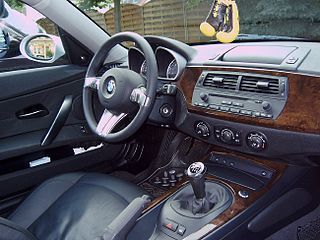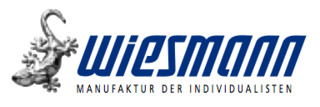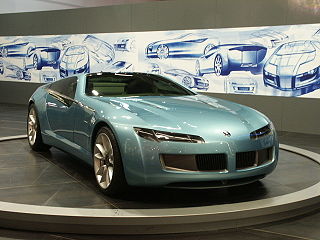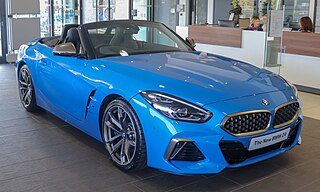
The BMW Z3 is a range of two-seater sports cars which was produced from 1995 to 2002. The body styles of the range are:

BMW M62 is a naturally aspirated V8 petrol engine which was produced from 1995 to 2005. A successor to the BMW M60, the M62 features an aluminium engine block and a single row timing chain.

The BMW E39 is the fourth generation of the BMW 5 Series range of executive cars, which was manufactured from 1995 to 2004. It was launched in the sedan body style, with the station wagon body style introduced in 1996. The E39 was replaced by the E60 5 Series in 2003, however E39 Touring models remained in production until May 2004.

The BMW E32 is the second generation of the BMW 7 Series luxury cars and was produced from 1986 until 1994. It replaced the E23 and was initially available with straight-six or V12 powerplants. In 1992, V8 engines became available. From its inception, the E32 was among the most technologically advanced series of cars in its day.

The first generation of the BMW Z4 consists of the BMW E85 and BMW E86 sports cars. The E85/E86 generation was produced from 2002 to 2008. The E85/E86 replaced the Z3 and is the third model in the BMW Z Series. Initial models were in the roadster (E85) body style, with the coupé (E86) body style being added in 2006. In February 2009, the BMW Z4 (E89) began production as the successor to the E85/E86.

BMW M GmbH, formerly known as BMW Motorsport GmbH, is a subsidiary of BMW AG that manufactures performance cars.

Wiesmann GmbH is a German automobile manufacturer that specializes in hand-built custom convertibles and coupes. Brothers Martin Wiesmann and Friedhelm Wiesmann founded the company in 1988 which has its headquarters located in Dülmen. The business was temporarily closed in May 2014, and following a buyout by London-based investor Roheen Berry who took over as CEO, it is set to return with a new model, powered by a BMW M division-sourced V8 engine. The relaunch of the Wiesmann brand has more than one model, including an electric vehicle, in the pipeline and the pre-development phase of the car has been completed. A teaser video of the brand's rebirth, posted on their website, tells viewers to “expect the unexpected”.

The Aston Martin Vantage is a series of hand-built sports cars from the British automotive manufacturer Aston Martin. Aston Martin has previously used the "Vantage" name on high-performance variants of their existing GT models, notably on the Virage-based car of the 1990s. The modern car, in contrast, is the leanest and most agile car in Aston's lineup. As such, it is intended as a more focused model to reach out to potential buyers of cars such as the Porsche 911 as well as the exotic sports and GT cars with which Aston Martins traditionally compete.

The Morgan Aero 8 is a sports car built by Morgan Motor Company at its factory in Malvern Link, England from 2000 until 2018.

Alpina Burkard Bovensiepen GmbH & Co. KG is an automobile manufacturing company based in Buchloe, in the Ostallgäu district of Bavaria, Germany that develops and sells high-performance versions of BMW cars. Alpina works closely with BMW and their processes are integrated into BMW's production lines, and is recognized by the German Ministry of Transport as an automobile manufacturer, in contrast to other performance specialists, which are aftermarket tuners. The Alpina B7 is produced at the same assembly line in Dingolfing, Germany, as BMW's own 7 Series. The B7's twin-turbo 4.4-litre V8 is assembled by hand at Alpina's facility in Buchloe, Germany, before being shipped to BMW for installation, and the assembled vehicle is then sent back to Alpina for finishing touches.

The Bertone Birusa is a concept car built in 2003 by Bertone and based on the BMW Z8. It debuted at the 2003 Geneva Motor Show. It was intended solely as a styling exercise and never went into production, neither intended to be supplied to any automobile producer, neither BMW, just a show car to gain projects.
The 420G is a 6-speed manual transmission manufactured by Getrag. It is designed for longitudinal engine applications and for use on engines producing up to 499 N⋅m (368 lb⋅ft) of torque.

The BMW Z4 (E89) is the second generation of the BMW Z4 range of two-door roadsters, and was produced from 2009 to 2016. The E89 replaced the E85/E86 Z4 and is the fourth model in the BMW Z Series.

The BMW Z models are a line of roadsters manufactured by German automaker BMW. The Z stands for Zukunft, and has been produced in four different series with six generations consisting of roadster, coupé, sports car, and concept variants.

The Alpina B6 (E63) is the second generation of the high performance grand tourer manufactured by German automobile manufacturer Alpina from 2005 to 2010. Based on the BMW 6 Series (E63), the car was available in coupé and convertible bodystyles. The B6 was introduced in 2005.

The Alpina B7 (E65) is the third generation of the high-performance BMW 7 Series manufactured by Alpina from 2004 to 2008. Based on the BMW 7 Series (E65), the B7 was officially introduced to the public at the 2003 Frankfurt Motor Show. The B7 was the first Alpina to use a supercharged engine and was available in normal and long-wheelbase versions.

The Alpina Roadster S is a sports car manufactured by the German automobile manufacturer Alpina from 2003 to 2007. Based on the BMW Z4 (E85), the Roadster S was unveiled at the 2003 Frankfurt Motor Show.

The Alpina B7 (F01) is the fourth generation of the high-performance BMW 7 Series manufactured by Alpina from 2011 until 2015. Based on the BMW 7 Series (F01), the car was introduced to the public at the 2010 Chicago Auto Show and was available in normal and long-wheelbase versions, with xDrive or rear-wheel drive. The B7's engine was hand-built at the Alpina factory at Buchloe and then sent to the BMW factory in Dingolfing to be put into the body shell. The car was painted and initially assembled at the Dingolfing plant and was then sent back to Alpina for final assembly. It was the second Alpina B7 to be offered in North America, with 1,740 examples imported and sold in the United States.

The Alpina B5 and D5 (F10) are a series of high performance executive cars manufactured by German automobile manufacturer Alpina from 2011 to 2016. Introduced at the 2010 Goodwood Festival of Speed, the car is the second generation of the B5 and succeeds the B5 (E60). Based on the BMW 5 Series (F10), the car was available in saloon and wagon bodystyles.

The Alpina B12 is a name given to high-performance luxury automobiles manufactured by German automobile manufacturer Alpina. The B12 originally succeeded the B11 4.0 in 1988 which was based on the BMW 7 Series (E32) and was also based on the same car. Subsequent models were based on the BMW 7 Series (E38) and the BMW 8 Series (E31). Production ended in 2001 when the 7 Series (E38) models were discontinued. The B12 was replaced by the B7 (E65) and the B6 (E63).


























